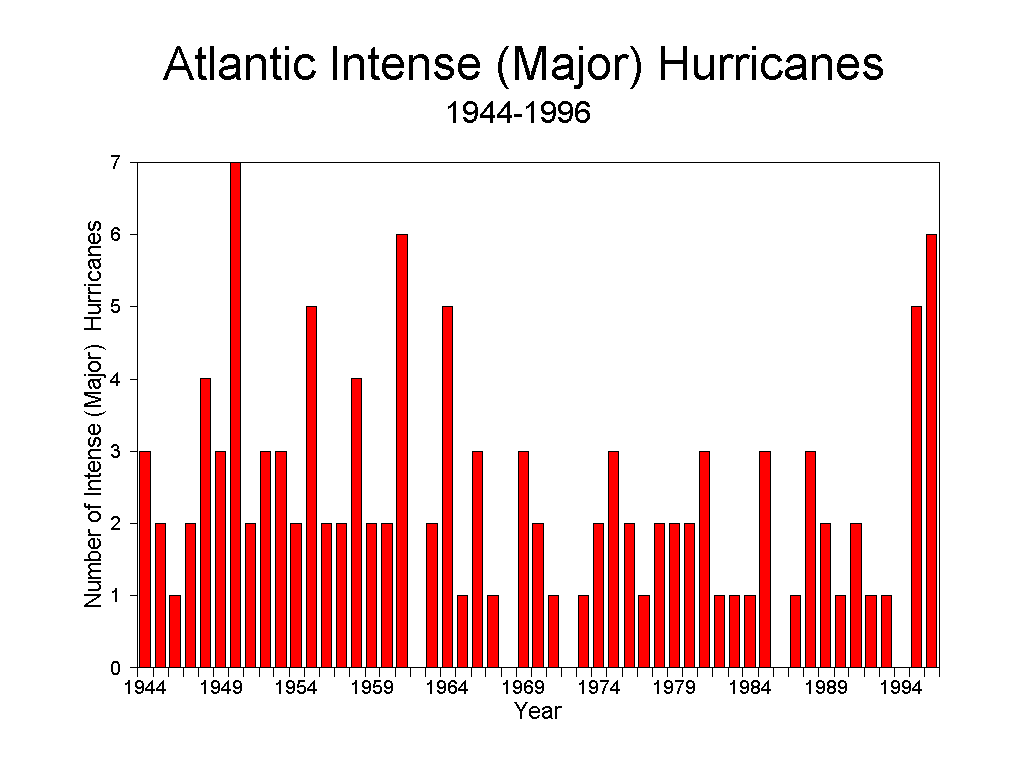Tropical cyclones and climate change
|
E. Linacre and B. Geerts |
9/'98 |
![]()
A review of evidence since 1996 (1) indicates that while the area over which SST’s exceed 26.5° C (one of the criteria for tropical cyclogenesis) is expected to expand in the next few decades, due to global warming, this will not significantly increase the number or intensity of tropical cyclones. This is because the upper atmosphere will also warm, reducing the energy efficiency of tropical cyclones. The distribution of tropical cyclones by intensity (e.g. on the Saffir-Simpson scale, Table 13.2 in the book) may change by only a few percent, though there are several uncertainties in this estimate.
In Australia, a tropical system with sustained surface winds of less than 18 m/s is called a ‘tropical depression’. It becomes a ‘tropical storm’ or ‘tropical cyclone’, and assigned a name, if winds are higher (exceeding 18 and 25 m/s, respectively). In the USA, the term 'tropical depression is not used. A 'tropical storm' emerges when the sustained surface winds exceed 17.4 m/s, and a class1 'hurricane' when they are at least 33.1 m/s. The mean annual frequencies of tropical storms (with winds over 17.4 m/s) and 'hurricanes' (over 33.1 m/s) are shown in Table 1.
Table 1. Mean annual number of tropical cyclones during 1970-95 in various ocean basins (1).
|
|
N. Atlantic |
E.N. Pacific |
N. Indian |
S.W. Indian |
S.W. Pacific |
N.W. Pacific |
total |
|
tropical storms+ hurricanes |
9.3 |
17.8 |
5.2 |
10.6 |
16.4 |
26.8 |
86.1 |
|
hurricanes |
5.0 |
10.3 |
2.0 |
4.8 |
7.5 |
16.4 |
45.9 |
The number of major hurricanes (at least class 2 or sustained surface winds of at least 42.5 m/s) in the Atlantic Ocean and adjacent seas has actually decreased from the mid 1960's to the late 1980's (Fig 1), a period of clear global warming. There are fewer hurricanes (and virtually no major hurricanes) in the Atlantic during El Niño years.

Fig 1. Major hurricanes in the Atlantic region between 1944 and 1996 (2).
There has been a decline also in the number of hurricanes originating in the Gulf of Mexico and later crossing the US Gulf Coast (between Cape Sable in Florida and Brownsville in Texas) (3). That number was 13 in the decade 1906-1915, 11 in 1926-35, 9 in 1946-55, 11 in 1966-75, and 8 in 1986-95. This may not mean a reduction in the number of hurricanes in the Gulf, but a change in the hurricane paths or longevity.
References
(1) Henderson-Sellers, A., H. Zhang et al., 1998. Tropical cyclones and global climate change: a post-IPCC assessment. Bull. Amer. Meteor. Soc., 79, 19-38.
(2) Landsea, C. W., N. Nicholls, W. M. Gray, and L. A. Avila, 1996. Downward trends in the frequency of intense Atlantic hurricanes during the past five decades. Geo. Res. Letters, 23, 1697-1700.
(3) Bove, M.C., D.F. Zierden, and J.J. O'Brien, 1998. Are Gulf landfalling hurricanes getting stronger ? Bull. Amer. Meteor. Soc. 79, 1327-8.